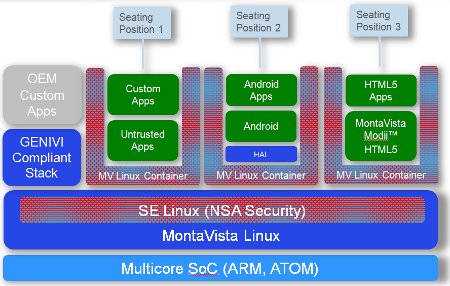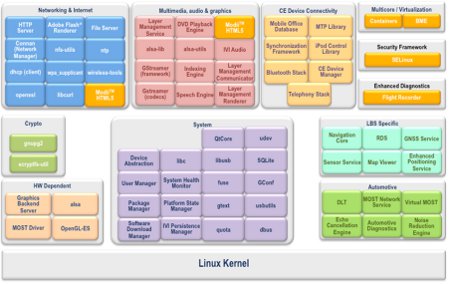MontaVista’s IVI stack hosts Android and HTML5 in virtual containers
Oct 10, 2011 — by Eric Brown — from the LinuxDevices Archive — 148 viewsMontaVista Software announced a Linux-based Genivi-compliant in-vehicle infotainment (IVI) software development solution that can support multiple Linux, Android, and HTML5 secure sessions on different screens within a car. The MontaVista Automotive Technology Platform (ATP) integrates SELinux security, MontaVista Linux's secure container implementation, and an in-house HTML5-based “Modii” browser, says the company.
In August, Cavium Networks' MontaVista Software subsidiary tipped its Automotive Technology Platform (ATP) with minimal details. ATP was listed by the open source Genivi Alliance as one of five Linux-based distributions said to be compliant with its latest open source IVI standard for automotive computers. Other compliant distros include Canonical's Ubuntu IVI Remix, Mentor Graphics' Embedded IVI Base Platform, MeeGo, and Wind River IVI.
Now, MontaVista is offering many more details on ATP, the latest version of which adds support for HTML5 and Android, two features that have yet to be part of Genivi platforms.

Simplified ATP architecture, including SDK and services integration
(Click to enlarge)
ATP is based on MontaVista Linux, offering hardened versions of MontaVista frameworks for graphics, video, sound, USB, Bluetooth, location based services (LBS), security, and customizable UI, says the company. MontaVista ATP is said to be optimized for performance, fast boot, and power management.
Included within the ATP framework is a software development kit (SDK), as well as a cross-development toolchain and MontaVista's DevRocket Eclipse IDE, says the company. ATP is also provided with professional services, automated test facilities, and project management services.
ATP supports both the original Intel Atom-based Genivi reference platform and the new ARM reference platform. Specific system on chip (SoC) support is said to include Freescale's Cortex-A8-based i.MX53, including Freescale's SABRE tablet design for the processor as well as the Cortex-A9-based Renesas R-Car M1 reference platform.
In a briefing with LinuxDevices, MontaVista Vice President of Marketing and Business Development Dan Cauchy said that Genivi's ARM platform has now matured to the point that it's every bit the equal of the Atom-based spec. Cauchy should know, since he's also a Genivi board member and chairman of Genivi Compliance.
MontaVista is primarily competing for Genivi clients with the Intel-owned Wind River, so it is understandable that it might push harder on ARM-based solutions. Its owner Cavium, which primarily makes high-end MIPS-based networking processors such as the Octeon, also offers some ARM11-based Econa processors and is planning a Cortex-A9 or -A15 introduction. (Cavium appears to be a long way from being in the IVI game, however, and may choose not to become so.)
Aside from some proprietary in-house IVI efforts, "Genivi is pretty much the only game in town," said Cauchy. "It's a very focused group, run primarily by automotive players." While no cars with Genivi-based IVI systems have yet hit the show floor, "we are now seeing automotive makers requiring Genivi compliance," adds Cauchy. "The Genivi spec is very customizable, letting each automotive manufacturer add its own GUI and services."
Linux Containers and SELinux
The latest version of ATP offers a new "Digital Media Solutions Platform," which adds an HTML5 framework and an Android runtime environment. As a result, Genivi IVI computers based on ATP will be able to run Android apps as well offer direct HTML5 web browsing and video sessions, says the company.
MontaVista has developed a secure containerization technology to meet the needs of multicore-based IVI systems that span two and sometimes three different displays. Multimedia-driven backseat screens have different requirements than the main front-seat display, which may also hook into telematics systems and be constricted by safety compliance.

Containers within typical multicore ATP implementation
(Click to enlarge)
This double layer of security greatly reduces the risk of compromised Android apps and HTML5 content infecting mission-critical automotive functions, says MontaVista. ATP also fully supports multicore processors and makes use of hardware acceleration for Android and HTML5 sessions, says the company.
The container technology "isolates things like the root file system and memory access, so users can bring in an untrusted Android app and isolate it," said Cauchy. "You can safely bridge the gap between Android and HTML5 on the one hand and the hardcore trustworthy automotive side on the other, so the rest of the system can't be hacked."
Cauchy said MontaVista is confident enough with its container technology that most customers probably do not need to implement the underlying SELinux framework, but it's there to add a second layer to reassure auto manufacturers. SELinux also lets manufacturers set different security levels for different implementations and seating positions.
The media-savvy HTML5 is supported, meanwhile, via a hithero-unheralded, in-house "Modii browser" that has been used in set-top box projects, according to Cauchy. Modii is one of numerous in-house and third-party open source components available to MontaVista Linux customers, and now to ATP customers as well, he added.

ATP architecture
(Click to enlarge)
"Linux is pretty rock solid and doesn't require a rapid cadence of updates," said Cauchy. "But while your Linux kernel will last for maybe three years, the Genivi spec is going to change every six to 12 months. We've set up ATP so it can be updated for Genivi updates roughly a month after each compliance spec release. And Android support can be updated even more frequently if need be."
Future enhancements to the Genivi spec include improvements to the layer manager, says Cauchy. "The layer manager arbitrates the screen between different apps, so if the navigation app can preempt the radio, or an incoming Bluetooth phone can be prioritized up or down," he added. Other ongoing projects include standardizing around security, one area in which Cauchy says MontaVista is "ahead of the curve."
MontaVista was the second embedded Linux software vendor to join the Genivi Alliance. The company announced its first Genivi-ready IVI design win in June 2010 with a multi-year partnership with Robert Bosch Car Multimedia. In June of this year, MontaVista announced a Genivi-based IVI reference platform collaboration with Rightware Oy, featuring the latter's Kanzi UI Solution.
Availability
MontaVista will be showing demonstrations of its Automotive Technology Platform (ATP) at the Genivi Alliance All Members Meeting at the Wyndham Hotel in San Jose Oct. 11-14.
This article was originally published on LinuxDevices.com and has been donated to the open source community by QuinStreet Inc. Please visit LinuxToday.com for up-to-date news and articles about Linux and open source.